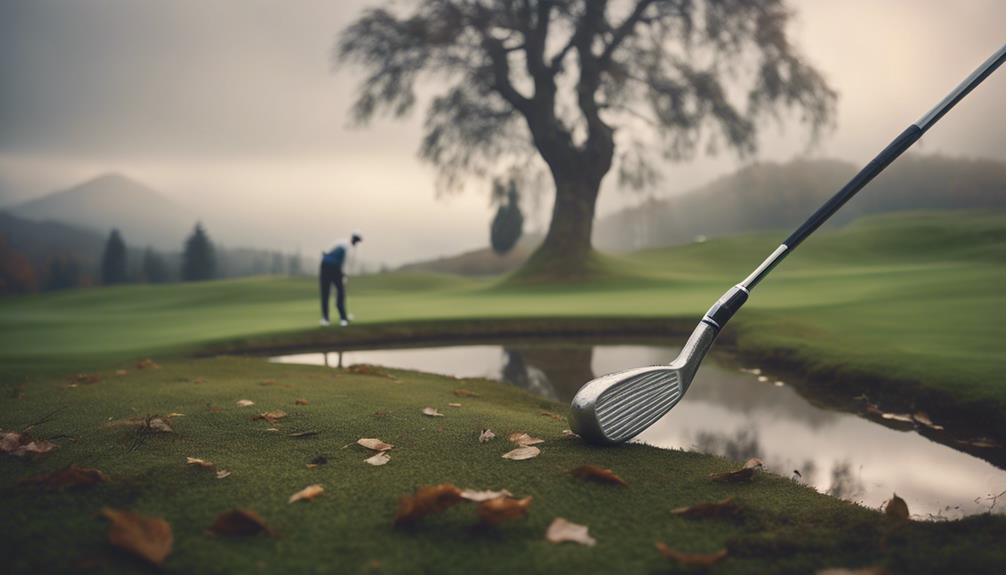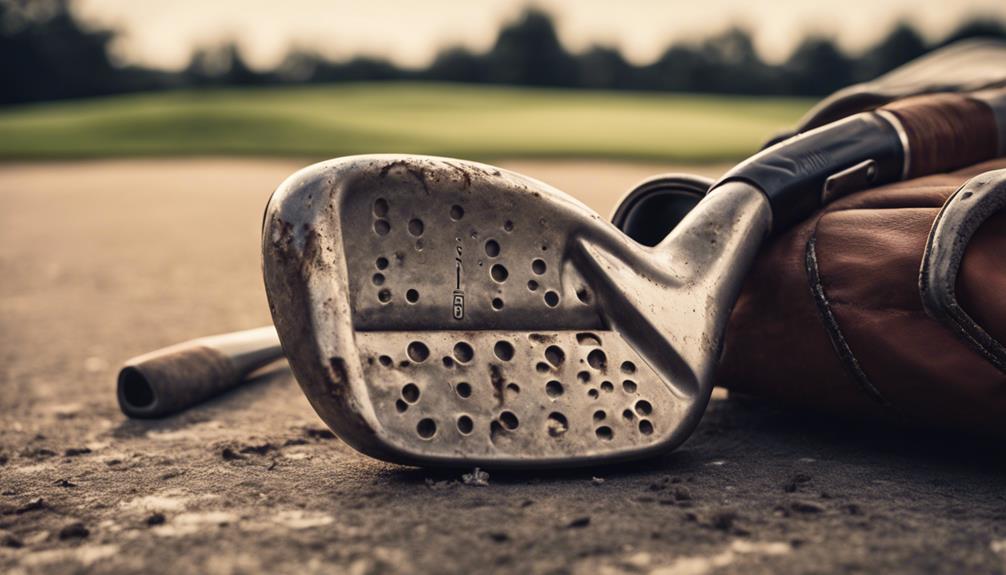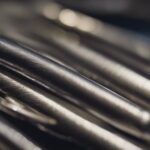- 7 Top Flite Golf Clubs XL for Improved Performance - September 28, 2024
- Top Flite Golf Clubs: Top 5 Reasons to Choose Them - September 28, 2024
- Top 3 Golf Club Fitters for a Perfect Swing - September 28, 2024
You can expect stainless steel golf clubs to withstand even the most brutal weather conditions and heavy use, thanks to their exceptional strength, corrosion resistance, and durability, which are rooted in their metal composition and design. With a yield strength of 100,000-150,000 psi, stainless steel clubs outperform carbon steel, making them more resistant to wear and tear. They're also resistant to corrosion, thanks to a minimum of 10.5% chromium content, which forms a protective layer. As you explore the benefits of stainless steel golf clubs, you'll discover how their durability and performance can elevate your game.
Key Takeaways
- Stainless steel golf clubs withstand harsh environments and heavy use without compromising performance due to their high yield strength.
- The chromium content in stainless steel forms a protective layer, guaranteeing durability and resistance to corrosion over time.
- Stainless steel clubs can last for decades with proper care, resisting wear and tear, and maintaining peak performance.
- The high-strength-to-weight ratio of stainless steel enables clubs to maintain their shape and structure even when subjected to intense forces.
- Chrome plating adds an extra layer of protection, enhancing durability and corrosion resistance without affecting the club's performance.
Material Strength Comparison
When comparing the strength of materials used in golf clubs, you'll find that significant differences exist among stainless steel alloys, titanium, and carbon steel, with 17-4 stainless steel and maraging steel standing out for their exceptional yield strength.
The yield strength of 17-4 stainless steel, commonly used in golf clubs, ranges from 100,000 to 150,000 pounds per square inch (psi), which is higher than that of 431 stainless steel.
Maraging steel, used in high-performance clubs, boasts an ultra-high yield strength of around 200,000-250,000 psi, making it one of the strongest materials used in golf clubs.
Titanium, used in driver heads, has a yield strength of around 130,000-140,000 psi, which is lower than that of 17-4 stainless steel but higher than that of 431 stainless steel.
In contrast, carbon steel, used in some irons and wedges, has a relatively low yield strength of around 50,000-80,000 psi.
Understanding these differences in yield strength is vital in determining the overall durability and performance of your golf clubs.
Corrosion Resistance Explained
As you consider the strength of materials used in golf clubs, it's equally important to examine how they resist corrosion, a critical factor in determining their overall durability and performance.
Stainless steel, used in many golf clubs, contains a minimum of 10.5% chromium, which forms a thin layer of chromium oxide on the surface, providing excellent corrosion resistance.
The addition of nickel further enhances this resistance, making it ideal for golf clubs exposed to various environmental conditions.
In fact, 17-4 stainless steel, a popular alloy used in golf clubs, has a corrosion rate of less than 0.002 mm/year, guaranteeing durability over time.
The finishing process also plays a vital role, with methods like passivation and electropolishing helping to remove impurities and create a smooth surface.
To meet ASTM standards, stainless steel used in golf clubs must withstand at least 240 hours of salt spray testing without showing any signs of corrosion.
This rigorous testing confirms that steel irons can withstand the rigors of regular use, making stainless steels a reliable choice for golf clubs.
Durability in Harsh Conditions

During intense weather conditions, such as torrential rain or scorching heat, stainless steel golf clubs prove their mettle by withstanding harsh environments that would otherwise compromise the performance of lesser materials.
You'll be relieved to know that stainless steel clubs can withstand heavy use and harsh conditions, making them a durable option for golfers who play frequently or in challenging weather conditions.
The high-strength-to-weight ratio of stainless steel enables golf clubs to maintain their shape and structure even when subjected to intense forces, such as those generated by high-speed swings.
This means you can swing with confidence, knowing your clubs can handle the impact.
Additionally, stainless steel's resistance to corrosion guarantees that your clubs won't degrade over time, even in humid or wet environments.
With proper care, your stainless steel golf clubs can last for decades, even with frequent use, due to their exceptional durability and resistance to wear and corrosion.
Chrome Plating Benefits
By adding a layer of chrome plating to stainless steel golf clubs, you're effectively shielding them from corrosion and wear, maintaining their performance and durability over time. This process involves depositing a thin layer of chromium onto the steel surface, which enhances the club's resistance to scratches and damage.
The benefits of chrome plating on stainless steel golf clubs:
- Enhanced corrosion resistance: Chrome plating fills in micro-pores on the surface, creating a smooth finish that reduces the risk of rust and corrosion.
- Improved durability: The chrome plating layer protects the club from wear and scratches, maintaining it durable even in harsh conditions.
- Aesthetic appeal: Chrome plating gives the clubs a bright, shiny finish that resists tarnishing and maintains its luster even after extended use.
- Consistent performance: The plating layer guarantees a consistent finish, which reduces the risk of performance variations due to surface irregularities.
- Added protection without excess weight: The plating thickness is carefully controlled to provide adequate protection without adding excessive weight or affecting the club's performance.
Lifespan of Stainless Steel Clubs

When you choose stainless steel golf clubs, you're investing in a durable product that can withstand the rigors of frequent play.
You'll want to know how long the club head will maintain its shape and structure, as well as the factors that affect the shaft's longevity.
Club Head Durability
Taking advantage of stainless steel's exceptional resistance to corrosion and wear, golfers can expect their clubs to maintain peak performance over an extended lifespan. This is especially true for the golf club head, which is subjected to the most wear and tear.
When it comes to club head durability, stainless steel clubs stand out from the rest.
- Unparalleled resistance to corrosion: Stainless steel's chromium content forms a protective layer, preventing rust and corrosion, and ensuring your clubs remain in top condition.
- Long-lasting performance: With proper care, your stainless steel clubs can last for decades, with some golfers reporting 20-30 years of use without significant degradation.
- Superior resistance to environmental factors: Stainless steel clubs are less prone to damage from extreme temperatures, humidity, and exposure to saltwater or chlorine.
- Outstanding scratch and dent resistance: Stainless steel clubs are more resistant to scratches, dents, and cracks than clubs made from other materials, such as titanium and aluminum.
- Peak performance, every time: With a durable club head, you can trust that your stainless steel clubs will perform consistently, shot after shot, round after round.
Shaft Longevity Factors
You can expect the lifespan of your stainless steel golf clubs to vary greatly depending on several key factors, including usage, storage, and maintenance.
The quality of the stainless steel alloy used in the club's construction also plays a significant role, with higher-grade alloys like 17-4 and 431 offering greater resistance to corrosion and wear.
When it comes to shafts, regular inspection and replacement of worn or damaged components can help extend their lifespan.
You should also pay attention to how you store your clubs, as improper storage can lead to damage and corrosion. For instance, storing your clubs in a humid environment or exposing them to extreme temperatures can reduce their lifespan.
On average, a well-maintained stainless steel golf club can last for around 5-10 years before it may need to be replaced due to wear and tear.
Rust Resistance Testing
To further guarantee the durability of your stainless steel golf clubs, manufacturers and testing organizations subject them to rigorous rust resistance testing, simulating the harsh conditions they'll face on the course.
This testing is essential in evaluating the corrosion resistance of the steel, which directly impacts the lifespan of your clubs.
When exposed to saltwater, humidity, and extreme temperatures, your stainless steel clubs are put to the test.
The American Society for Testing and Materials (ASTM) sets standards for rust resistance testing, including the G48-11 standard for pitting and crevice corrosion resistance.
Some stainless steel alloys, like 17-4 and 431, have higher corrosion resistance than others, making them more suitable for golf clubs.
Stainless steel golf clubs have a lifespan of approximately 10 to 15 years before showing signs of rust and corrosion.
Proper cleaning, storage, and maintenance can extend the lifespan of your clubs.
Rust resistance testing involves exposing clubs to harsh conditions to evaluate their durability.
The ASTM sets standards for rust resistance testing.
Some stainless steel alloys have higher corrosion resistance than others.
Maintenance for Optimal Performance
How do you guarantee your golf clubs continue to deliver peak performance round after round? The answer lies in regular maintenance. By incorporating a few simple habits into your routine, you can maintain your steel golf club heads' soft feel and top-notch performance.
| Maintenance Task | Frequency |
|---|---|
| Clean clubs with mild soap and soft cloth | After each use |
| Store clubs in dry environment | Ongoing |
| Inspect clubs for damage | Monthly |
| Regrip clubs | Every 6-12 months |
Regular cleaning prevents dirt and debris from affecting performance, while storing your clubs in a dry environment prevents rust and corrosion. Avoiding extreme temperatures and inspecting your clubs regularly can help identify and address any issues before they affect your game. Finally, regripping your clubs every 6-12 months guarantees a consistent feel and control. By following these maintenance tasks, you can trust that your golf clubs will continue to deliver peak performance round after round.
Frequently Asked Questions
Do I Want Graphite or Steel Shafts?
You're deciding between graphite or steel shafts, considering your swing speed and shaft flex. If you generate high club head speed, steel shafts provide more control, while graphite suits slower swings, promoting higher ball flight and forgiveness.
Is Titanium a Metal Used to Make Golf Clubs?
You're considering titanium golf clubs, which boast exceptional strength-to-weight ratio, high-strength, and low-density properties, offering benefits like increased distance and accuracy, with a rich history in golf, and alternatives like stainless steel, but at a premium price.
How Do I Keep My Golf Clubs From Rusting?
You prevent rust on your golf clubs by controlling moisture, storing them in a dry place, and using gentle cleaning methods with mild soap, ensuring a rust-free game every time.
How Do You Polish Stainless Steel Golf Clubs?
To master club maintenance, you'll learn steel cleaning techniques, focusing on polish application and buffing to restore shine. Apply polish in circular motions, targeting scratches, then buff with a clean cloth to reveal a high-shine finish.
Conclusion
As you wrap your hands around the grip, you expect your golf clubs to withstand the wear and tear of watery wedges, sandy swings, and rough rounds.
And they do, thanks to stainless steel's stalwart strength.
Silky smooth shots are sustained by steel's superior scratch resistance, shielding against corrosion's crippling creep.
With proper care, your clubs will continue to crave contact, coursing through countless competitions with precision and perfection.




